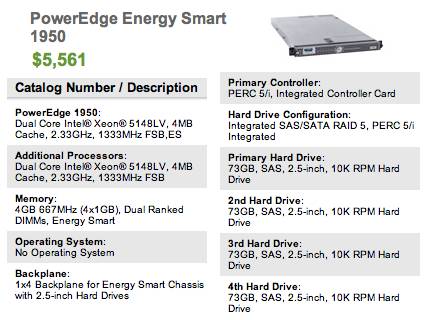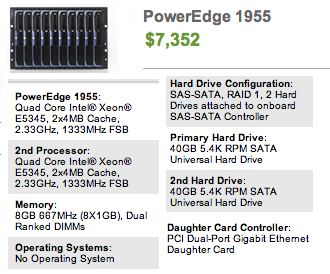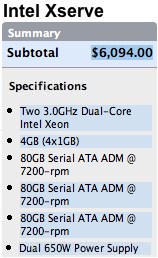A followup to my article that generated a lot of traffic and comment.
Point of clarification: the Minis in this system are only doing one thing: executing PHP.
They don’t serve up image files or store anything persistent on disk. They all communicate to a central database system that has proper redundancy built in.
Since the Minis in this application don’t use any local disk resources other than to store PHP code, if a Mini were to fail or fall out of the set for some reason, the system as a whole still runs. The redundancy you would normally have built into a bigger beefier server (and pay extra for) is handled by just having more servers. Google does the same thing. When a server in their system dies they really don’t care too much because they built their redundancy in through sheer numbers. For the price of 2 well outfitted Intel Xserves, I can purchase 12 MacMinis and use less power (~ 4.2A) and 2-3 times more processing power and have a LOT more redundancy.
Based on the wording of articles linking to my post (and perhaps my own wild performance claims), there seemed to be an inordinate amount of chatter focusing on how the MacMini was faster than the Xserve G5 in cpu performance, when that wasn’t the primary concept I wanted to convey about why the Mini’s are a good fit for a front end web farm. (Perhaps better writing skills would help)
My main thrust was that the balance between price, performance, power consumption, heat generation and reliability (Apple has on average produced better and longer lasting hardware) of the MacMini was hard to match.
When compared against traditional blade systems like what is offered by IBM, Dell, HP, etc.., it’s obvious one loses certain features. Primarily these are centralized management tools, unified chassis for power and network cabling amongst others. However those hardware systems cost more overall
In deploying networked systems, really in life, one must balance certain choices.
For this application for this client, the MacMini has the right balance in all those critical areas.
Some example hardware configs I threw together for comparison of performance, cost, power:



![]()
For comparison sake, I’m going to use the Mini’s 1.66 Ghz Core Duo cpu as a base unit. One Mini has 2 each of the “core-unit”. Also, I tried to maintain a 1GB of RAM per core.
I’m going to make up another value: Power Ratio. This is Amps per core-unit. For example: a MacMini has a Power Ratio of 0.15
So, assuming a minimum of two systems for redundancy:
- Two Intel Xserves
Price: 2 x $6,400 = $12,800
MacMini equivalent: 12 = 24 core-units
CPU: 3.0 Ghz so each is worth roughly two core-units = 16 core-units
Power: Minis – 12 x 0.3A = 3.6A; XServes – 2 x 3A = 6A
Power Ratio: 0.125 Amp per core-unit
Space: 4U vs 2U
— - Two Dell PowerEdge 1950s
Price: 2 x $5,600 = $11,200
MacMini equivalent: 11 = 22 core-units
CPU: Dual 2.33Ghz Quad Core cpus = 8 cores with each core worth 1.5 core-units = 24 total core-units for two systems
Power: Minis – 11 x 0.3A = 3.3A; Dell1950 – 2 x 3A = 6A (assuming the same usage as most Dual Xeon systems with dual PS)
Space: 4U vs 2U
— - Two Dell PowerEdge 1955 Blades and Chassis
Price: 2 x $7,352 + ~$5,000 = $20,000
MacMini equivalent: 19 = 38 core-units
CPU: Dual 2.33Ghz Quad Core cpus = 8 cores with each core worth 1.5 core-units = 24 total core-units for two blades
Power: Minis: 14 x 0.3A = 4.2A; 1955 Blades – The chassis uses 2 x 2100W power supplies, so I’m going to assume the power usage for a fully loaded chassis (10 blades) uses 3.5 times the power that a single Dual Xeon that has a 650W power supply has which is 10.5A. Take away 1A for the Chassis itself and you get about 1A per blade. So a PE1955 Chassis with 2 blades should consume roughly 3A.
Power Ratio: 0.125 Amp per core-unit
Space: 6U vs 7U
— - Five Dell PowerEdge 1955 Blades and Chassis
Price: 5 x $7,352 + ~$5,000 = $41,000
Mini equivalent: 41 MacMinis (82 core-units)
CPU: Dual 2.33Ghz Quad Core cpus = 8 cores with each core worth 1.5 core-units = 60 total core-units for five blades
Power: Minis: 41 x 0.3A = 12.3A; 1955 Blades: 5x ~= 6A
Space: 8U vs 7U
Some interesting choices here. Not exactly a scientific analysis, but the Mini definitely holds its own against the single unit servers. Against the Blade Systems, it’s a closer call especially with the ability to choose 2 x Quad Core cpus for the Dell Blades. The best part of the blade system is that the power usage grows so much slower per unit of performance than any other system. 12 core-units per 1A of power is an excellent value. Power Ratio of 0.833
Our client has expressed interest in adding 2-3 more minis to the set and I think we will give Debian/Ubuntu a shot this time for comparison
One person on the ArsTechinca comment section did make an interesting point as to why you would want to run an OS X machine for a web front end: WebObjects.
So, thanks for reading everyone, it’s always interesting to throw something out there and see what has to be said about it.
Brian
[…] http://www.networkjack.info/blog/2007/04/04/intel-macmini-blade-server-followup/ Point of clarification: the Minis in this system are only doing one thing: executing PHP. […]
Are the power figures derived by measuring the servers performing the actual task? This is the only reliable way to get accurate power consumption numbers.
1. No.
2. Of course, that is understood.
The numbers for the Minis are real.
The numbers for the other devices are either derived from actual numbers of similar type servers (IBM x336 for the Intel Xserves) or by estimating based on literature available for the items.
As I said, it wasn’t meant to be any sort of exact comparison, but merely a ballpark estimate of the value of each approach to a high-density web front-end.